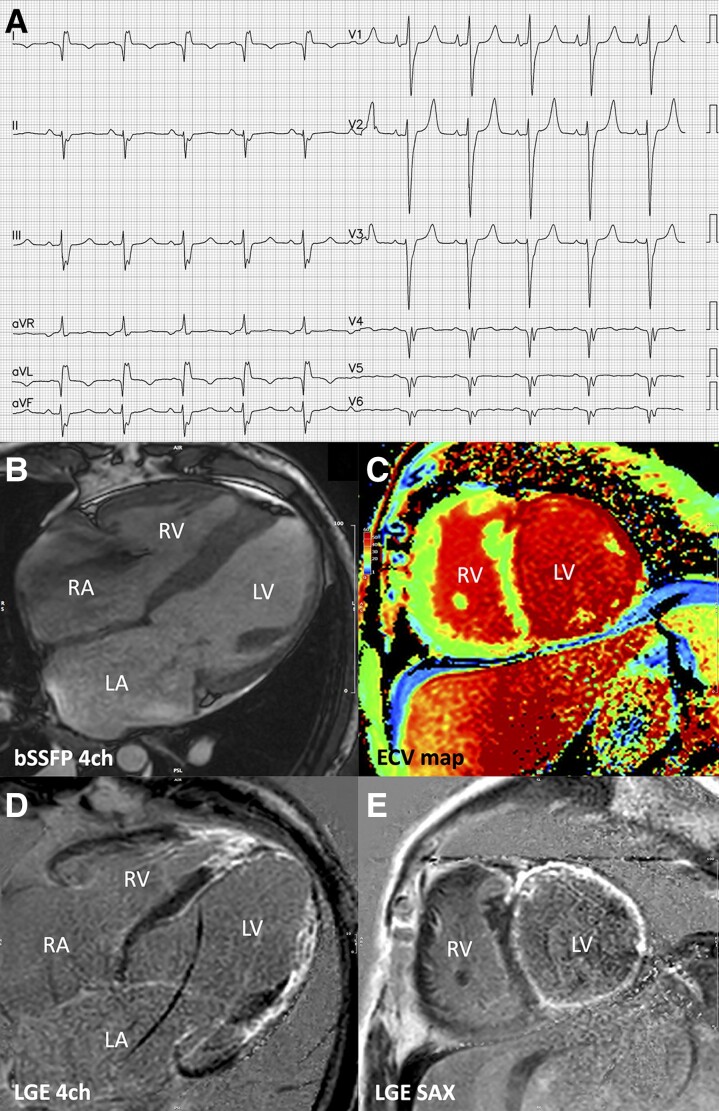A 37-year-old male patient with Type IIIa glycogenosis presented to our cardiology department with clinical features of worsening heart failure. Laboratory evaluation unveiled chronic myocardial injury, elevated B-type natriuretic peptide concentrations (3830 pg/mL), and impaired hepatic and renal function. Electrocardiographic analysis depicted sinus rhythm, positive Cornell voltage criteria suggestive of left ventricular hypertrophy, diffuse QRS fragmentation with postsilon waves, and pseudo-infarct anterolateral Q waves in anterolateral precordial leads (Panel A). Echocardiographic evaluation showed dilated left ventricle with severely reduced ejection fraction and granular sparkling appearance of the interventricular septum. Cardiovascular magnetic resonance confirmed the presence of severe biventricular dilatation, severely impaired biventricular systolic function (Panel B; Supplementary material online, Video S1), and moderate functional mitral and tricuspid regurgitation and showed extensive extracellular volume expansion (Panel C) with circumferential transmural late gadolinium enhancement involving mid-apical segments of the left ventricle, with direct extension into right ventricular free wall (hook sign), and relative sparing of the interventricular septum (Panels D and E). The treatment plan focused on the comprehensive management of advanced heart failure, modified Atkins ketogenic diet, and monitoring of selenium levels. We described a case of burnt-out hypertrophic cardiomyopathy associated with Type IIIa glycogenosis, also known as Cori–Forbes disease. This rare autosomal recessive storage disorder is characterized by a deficiency in glycogen debranching enzyme activity, which causes the accumulation of glycogen in the liver and skeletal muscles, with variable cardiac involvement. In some instances, it can lead to overt hypertrophic cardiomyopathy phenotype. Multi-modal imaging is key to revealing the very uncommon hypokinetic-dilated progression of Cori–Forbes cardiomyopathy.
Supplementary Material
Acknowledgements
The ECG was enhanced and digitized using the PMcardio smartphone app. You can download the app here: https://bit.ly/pmcardio-pub
Contributor Information
Kristian Galanti, Department of Neuroscience, Imaging and Clinical Sciences, ‘G. d'Annunzio’ University of Chieti-Pescara, Via Luigi Polacchi, 11 - 66100 Chieti, Italy.
Mario Di Marino, Department of Neuroscience, Imaging and Clinical Sciences, ‘G. d'Annunzio’ University of Chieti-Pescara, Via Luigi Polacchi, 11 - 66100 Chieti, Italy.
Cesare Mantini, Department of Neuroscience, Imaging and Clinical Sciences, ‘G. d'Annunzio’ University of Chieti-Pescara, Via Luigi Polacchi, 11 - 66100 Chieti, Italy.
Sabina Gallina, Department of Neuroscience, Imaging and Clinical Sciences, ‘G. d'Annunzio’ University of Chieti-Pescara, Via Luigi Polacchi, 11 - 66100 Chieti, Italy.
Fabrizio Ricci, Department of Neuroscience, Imaging and Clinical Sciences, ‘G. d'Annunzio’ University of Chieti-Pescara, Via Luigi Polacchi, 11 - 66100 Chieti, Italy; Department of Clinical Sciences, Lund University, Jan Waldenströms gata 35, 214 28 Malmö, Sweden; Fondazione Villa Serena per la Ricerca, Viale L. Petruzzi, 42 - 65013 Città Sant'Angelo, Pescara, Italy.
Supplementary material
Supplementary material is available at European Heart Journal – Case Reports.
Consent: The patient has given his consent for the use of his medical data and images.
Funding: 2019 Search for Excellence Starting Grant, G.d’Annunzio University of Chieti-Pescara
Data availability
No new data were generated or analysed in support of this research.
Associated Data
This section collects any data citations, data availability statements, or supplementary materials included in this article.
Supplementary Materials
Data Availability Statement
No new data were generated or analysed in support of this research.



